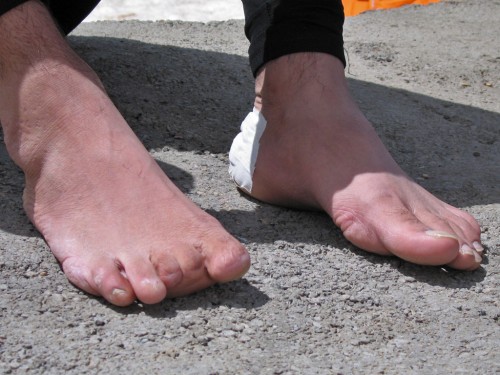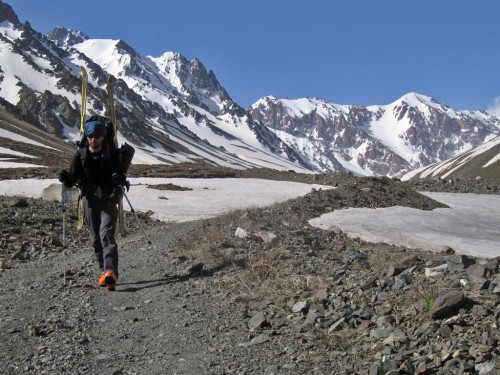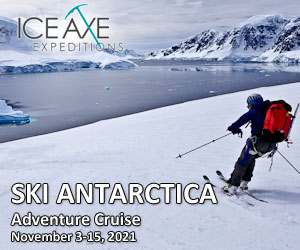Insoles
When I was into Alpine Racing, one sign of how serious you were about the sport was if you went to the trouble and expense of getting custom made orthopedic footbeds. The idea was that you wanted your foot perfectly supported, but more importantly, totally flat so you weren’t inadvertently riding an edge. We were all convinced that our feet were freaks of nature, but I’ve come to realize that I have pretty normal feet and that everyone thinks his/her feet are weird.

Now these are some truly weird feet. Madjeed from Iran, who lost his toes while searching for a lost friend in the mountains. He was happy with any boot as long as it was within a few sizes of his actual foot.
The custom made footbeds didn’t do squat for my racing, but I did love the perfect fit I got out of them. When they finally died, I was psyched to find that the off-the-shelf Superfeet insoles were at least as good, if not better. They were definitely cheaper. A nice feature of Superfeet is that they come in a variety of sizes and shapes so you can most likely find something to fit your foot. Between these and thermoforming liners, I haven’t had a blister from my backcountry boots in years.
Some BC boots come with high-end insoles and some don’t. I’ve heard that the BD boot insoles are almost carbon copies of the Superfeet, which is great if they fit your foot, but a bummer if not as you then have to pitch them and get new insoles anyway.

You do a lot of walking in touring boots, so you want an insole that is comfy and durable. James Alexander Valahos walking in Iran's Alum Koon (spelling?) range.
Unlike Alpine skiing where your foot is mostly static, in the backcountry you are doing a lot of striding, stomping, skiing, walking, etc., so you want a durable insole. I usually buy the green Superfeet insole, but recently they came out with a skiing version, which is not only a sexy red color, but it also has foil on the backside to help reflect heat. I’ve found I can get many (six or more) seasons out of a pair of insoles and usually swap them up whenever I get a new pair of boots.
________________________________
Help support StraightChuter.com and slip into some sexy, red Superfeet Premium Insole from Backcountry.com. Click on the photo below…
Category: Gear Reviews










Aren’t the BD insoles moldable…therefore able to fit many shapes of feet?
???? Will heat moldable footbeds bake and squish out when touring and hiking in the hot spring sun and it’s 200 degrees in my AT boots?
I don’t use the BD insoles, so I don’t know. But I’d have to wonder about the very concept of a moldable insole..? In my case, I WANT arch support, so why would I thermoform my insoles to fit my flat feet? I can see it on a liner where it is enveloping the top of your foot, but as a footbed, it just seems like another little dubious value-added bullet point.
As far as them being durable or not, that is for you, the first generation customer, to figure out as part of the famous “Customer Field Testing” program.
Shimano used to make cycling shoes that had heat moldable insoles. If you left your shoes in the hot car and you were able to slip the shoes on while they were hot, it was like stepping in a nice warm marshmallow insole. If they expanded and then cooled, the fit was tight. Mine were quickly replaced with Superfeet insoles.
No blisters in touring boots ever? I can only dream of that. My heels have two blisters on each side as I sit here right now. Maybe I’m not living right.
now i can add to the rainbow of superfeet i have, though i will advise that the recommended app for them may not be as strict as the labeling. i go with green as a matter of course, but some are softer or thinner than others and may be better depending on use. i have them in my mtn bike shoes, trail runners, 2 buckle t-2s for hiking, terminators for lift-served, both kick-n-glide and skate boots, and in my sorels for better grip.
tmi, i know.
Were you compensated by Superfeet for such a glowing review? Sorry, couldn’t resist…
; )
I love my InstaPrint insoles in my Zero 4 Carbons. We actually scored the underside, so they were a little more “flexy” or, would accomodate a slightly rockered AT boot better…and be more comforatble for hiking. It may just be a Jedi Mind trick, but it seems to work and they are great.
I have heard great things about the Superfeet for skiing/hiking, maybe time to try out a pair.
Anyone use the Montrail Enduro Soles or SOLE insoles for their skiboots?
Hi Mike – hehehe.., no, I wasn’t and it was just the other way around, I’ve chucked down for 5-6 pairs of them over the last few years. That said, there are probably other good insoles out there, but in my case, I figure why mess with success? They work for me and make a big difference for touring.
Hey Mike! I’ve used the Soles insoles for the last few years and put the Slim Support model in my Titans for this year. More customizable than the Superfeet…which tend to have too much arch support for me.
I’ve been finding my Surefoots last for at least 5-6 years (transfering to shoes etc.) and they’re custom. Have you ever tried those Andrew? Anybody have any comments on those? I wonder if there’s insulation ratings/information available on footbeds.
I just been trying the Sole footbeds in some slick new Haglofs hiking shoes. They’re heat moldable or wear in but ultimately an auto/custom unit. Could well work for ski/AT-boots but I haven’t tried. It starts with a good high arch. I have very little experience with them so far and haven’t been for a full on hike with them(durability etc.) but I can honestly say they’ve been truly super comfy on the “wear in” mode. I’d love to try to heat a fresh pair to see the difference.
I haven’t tried the Surefoot models, so I don’t personally know. Different boots fit different feet and it is the same with insoles. I guess if the insole fits, wear it. ;)
I use surefoot footbeds with my scarpa spirit 3’s. They work well and as you mentioned last a while.
He Andrew, are you too busy skiing? post something i m having withdrawal symptoms…
Hey Andrew,
as a podiatric student, I love this post, makes me happy to see people taking care of their feet!
Insoles are a pretty killer good deal for feet, if done with the correct person. Only about 20% of people have the “ideal” foot type, and even they have their own problems. Superfeet and the likes typically work with an insole model called “accomodative”, which is the idea to cushion the foot problem as is. That being said, several companies have started to add arch support, which typically takes care of the pronation problem (flat feet). If they work for you, awesome! Many people have problems that aren’t just by arches (crazy twists in their bones and the such) that lead them to podiatrists and orthopods. With these problems, most will be put into what is called a “functional” orthotic, which actually fixes the problem, placing the person into a better foot position for movement.
I recommend the Ed Viesturs SOLE insoles for boots. I’ve used them and love them.
can’t wait to see more posts, especially from AK, the homeland! Ohio is killing me!
Hi cjet – thanks for the info! I just happened across a pair of the Ed Viesturs SOLE insoles and am looking forward to trying them out.
Interestingly enough (or probably boringly, for most people) I’m guessing the aluminum doesn’t do much.
Metallic shielding only works with an air (or other gas, or vacuum, or translucent/transparent solid/liquid) gap because their ability to slow heat transfer is only really in the radiative realm. Smooth metallic surfaces tend to by high reflective of incident radiation and also happen to be very poor emitters (since for opaque solids, coef. of emissivity plus coef. of reflectivity = 1).
That’s why space blankets made from aluminized mylar work well. Your body is (mostly) in contact with it on one side. The blanket heats up as a result of this contact, but because the aluminum is a poor emitter, energy is retained to you in the blanket rather than being lost to cooler surrounding objects and outer space. (They also tend to block most of your convective losses too, since they are an effective moisture barrier.)
In this instance, because the foil is in contact with two opaque solids on either side, it performs its function as a good conductor of heat and would only very slightly slow the conductive transfer. Radiation doesn’t come into play because of the physical contact of the radiatively opaque objects.
Redux- the foil doesn’t help insulate from a radiative standpoint. It will provide small additional conductive resistance, but not much since it’s a good conductor.
I apologize to anyone who passed out or went catatonic reading that.